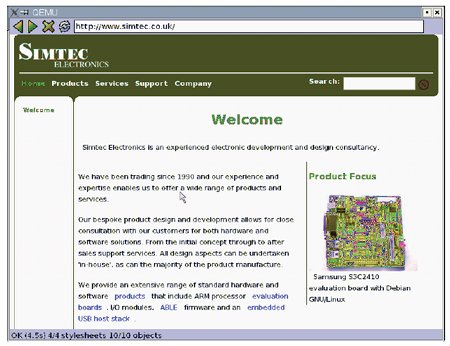Tutorial: A web kiosk embedded system
Apr 19, 2009 — by LinuxDevices Staff — from the LinuxDevices Archive — 138 viewsForeword — This article continues a series of tutorials on embedded Linux system development contributed by noted ARM Linux kernel hackers Vincent Sanders and Daniel Silverstone. In the initial installments, the Simtec engineers first described how to build a simple embedded system, then how to add a simple web server.
Papers in the series have been contributed to LinuxDevices by Simtec Electronics, a 20-year-old U.K.-based company specializing in embedded hardware and software services, with special expertise in ARM Linux.
The series will include:
- Building a simple embedded system
- Building an embedded Linux system with a web server
- Building an embedded Linux web kiosk (this paper)
- Building an ARM-based embedded Linux web kiosk
- Improving an embedded Linux system
- Deploying embedded Linux systems
Enjoy . . . !
by Vincent Sanders and Daniel Silverstone
Introduction
This is the third article in a series demonstrating the fundamental aspects of constructing embedded systems using Linux. This article covers the construction of a web browser with a command shell on the serial console. It assumes a basic understanding of a Linux-based operating system. Practical examples listed here are based upon a Debian- or Ubuntu-based distribution.
Pushing the limits
So far in this series we have used binaries from the host system or from pre-packaged software. We will now expand this to the inclusion of software built from source. This involves only a little more effort than the previous examples in terms of configuration script complexity, but there is an increasing burden of attempting to support additional methods of user interaction.
The primary cause of this increase in complexity comes from the additional kernel driver modules required to make the input and output devices operational. We saw in the previous web server example that drivers were required for each network card we wanted to support. For supporting two network cards (PCI NE2000 for QEMU and e1000e for a ThinkPad laptop) we added three modules.
In this project we need the modules necessary to support the input event system and the drivers to run the hardware. To support a minimal useful set, for mice and keyboards attached via USB HID and PS/2, the count runs to some eleven modules. This is further exacerbated by the need to have output using the framebuffer. To support the intelfb driver (for a Thinkpad laptop) and the cirrusfb driver (for QEMU) requires an additional twelve modules.
As these numbers demonstrate, a relatively small increase in supported interfaces rapidly increases the number of drivers required. We are also rapidly approaching the limits of what static module insertion is capable of and would need to start dynamically loading modules according to what hardware is present.
Selecting a browser
To have a web kiosk application we obviously need a browser. We could attempt to run Firefox or a Webkit browser using the X windows system but the dependencies for X and such a browser would make our resulting system huge which is undesirable.
One possibility for improving the situation might be to use a graphics library other than X, such as DirectFB with toolkit support. This appears appealing at first glance, but still requires a large number of libraries and a lot of software which is not frequently tested and hence will probably contain numerous issues we have to solve.
Another possibility is a browser which outputs directly to the Linux framebuffer. This possibility appeals as there is no need for a large toolkit and graphics library and browsers of this type tend to be smaller than their X based siblings.
After some searching, three candidate browsers that run directly on the Linux framebuffer were found:
- Zen — A small browser which implements only basic layout. It removed itself from serious consideration as its author clearly states that all development has ceased.
- Links — The Links browser is relatively small and supports HTML 4; however, its lack of CSS support and various build issues reduce its appeal.
- NetSurf — The NetSurf browser has several build targets, including GTK, so it might have been a contender for the DirectFB and GTK type approach. In addition, however, it supports several framebuffer type display options including the Linux framebuffer. It is in current development and has support for HTML 5 and CSS although it lacks JavaScript support.
Based on the available choices, NetSurf using the Linux framebuffer front-end was selected.
Building the browser
Building the NetSurf browser is suprisingly simple. Since the Linux framebuffer port has not been included in an official release, it must be built from the project's Subversion repository. This is not generally recommended for embedded systems, but there is little other option at this time.
First the NetSurf development trunk should be checked out using Subversion:
$ svn co svn://svn.netsurf-browser.org/trunk/netsurf |
Within the checkout (in the
netsurf/ directory) there is a document called Docs/BUILDING-Framebuffer which describes the steps necessary to build the browser.The summary of operations is to install and build the library dependencies, place a configuration makefile fragment in the NetSurf directory and run make TARGET=framebuffer.
$ sudo apt-get install build-essential libcurl3-dev libxml2-dev |
The
Makefile.config.override should contain the lines:NETSURF_FB_FONTLIB=freetype |
This configures the use of the Linux framebuffer frontend and the FreeType 2 library for font handling. Once the compile has completed it should produce an
nsfb-linux binary.Putting it all together
We will be using the same mkbusyfs.sh script from our previous examples; indeed you can continue using the previous installation and simply add configurations as the series progresses.
The configuration script for the web kiosk system is straightforward. The only especially interesting item is the number of kernel modules which, as already discussed, has grown considerably.
The mkbusyfs.sh tool should be used to generate the
webkiosk.gz which can then be tested with QEMU. The QEMU command line is slightly different to previous examples as it must redirect the console to a serial port so the video hardware can be used for the graphical framebuffer.qemu -kernel ./vmlinuz-2.6.26-1-686 -initrd webkiosk.gz |
Several issues were experienced with QEMU and only after resorting to installing the latest version from the QEMU Subversion repository was graphical output obtained. As can be seen, the output is still not correct. It was not determined whether this was another issue with the emulated video card, or with the browser.

Figure 1 -- QEMU video display
(Click to enlarge)
The pre built Kernel and generated output for an x86 system are available.
Putting it on a real system
It was decided to test the system on a real machine. A Lenovo ThinkPad T61 was available. This machine has an Intel i915 chipset which is supported by the intelfb driver resulting in a usable graphical framebuffer.
As in the first article, syslinux is used to make a USB stick bootable. The syslinux.cfg used was:
default webkiosk |
The laptop was booted from the USB stick, and the web browser started as expected with the correct colors.
What's next?
This third example extends the ideas from the previous two articles and produces a useful embedded system. It also demonstrates that as the ways a user interacts with the system become more diverse the system's complexity rises. Finally there is also an indication that as the target system's hardware becomes diverse (e.g. multiple possible video cards), the number of drivers must also rise and unexpected behavior is more likely to be experienced -- as demonstrated by the odd colors from the QEMU video card emulation.
The next step will be to apply the web kiosk example to a specific embedded hardware platform and compare how this alters the system's construction and usage.
This article is copyrighted 2009, Simtec Electronics, and reproduced here with permission.
About the authors
 Vincent Sanders is the senior software engineer at Simtec Electronics. He has extensive experience in the computer industry, having worked on projects from large fault-tolerant systems through accounting software to programmable logic systems. He is an active developer for numerous open source projects, including the Linux kernel, and is also a Debian developer.
Vincent Sanders is the senior software engineer at Simtec Electronics. He has extensive experience in the computer industry, having worked on projects from large fault-tolerant systems through accounting software to programmable logic systems. He is an active developer for numerous open source projects, including the Linux kernel, and is also a Debian developer.
 Daniel Silverstone is a software engineer at Simtec Electronics, and has experience in architecting robust systems. He develops software for a large number of open source projects, contributes to the Linux kernel, and is both an Ubuntu and Debian developer.
Daniel Silverstone is a software engineer at Simtec Electronics, and has experience in architecting robust systems. He develops software for a large number of open source projects, contributes to the Linux kernel, and is both an Ubuntu and Debian developer.
This article was originally published on LinuxDevices.com and has been donated to the open source community by QuinStreet Inc. Please visit LinuxToday.com for up-to-date news and articles about Linux and open source.